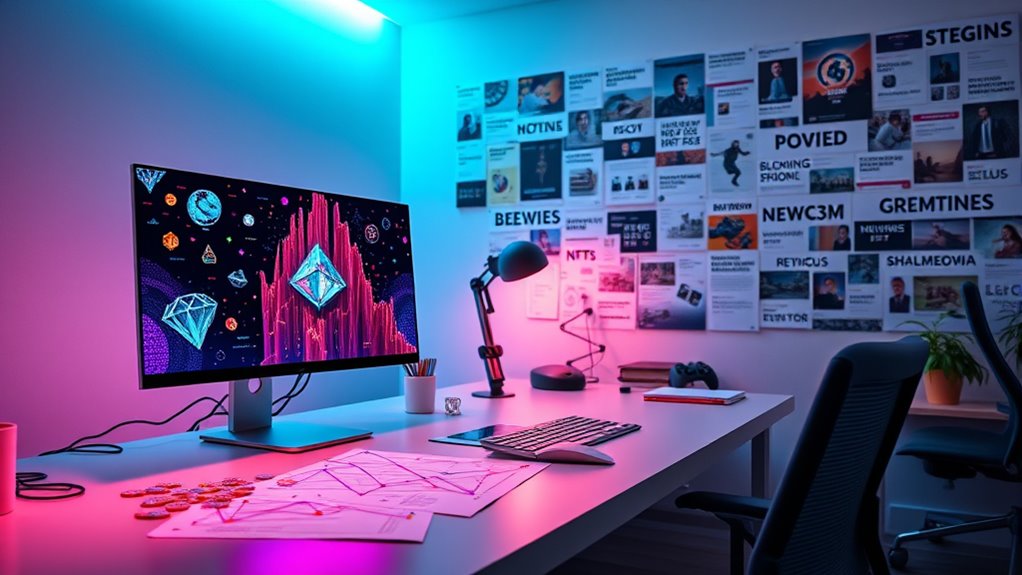NFTs started as an obscure tech term, mainly known among enthusiasts, but have quickly become a global buzzword transforming digital ownership. You can now verify, buy, and sell unique digital assets like art, music, and virtual land with blockchain technology that offers transparency and security. Smart contracts empower creators to earn royalties, reshaping the industry. If you stay curious, you’ll uncover how NFTs continue to impact far beyond digital art, shaping future digital economies.
Key Takeaways
- NFTs evolved from niche tech terminology to a mainstream concept impacting digital ownership and commerce worldwide.
- Blockchain technology provides transparent, secure records that verify and authenticate NFT ownership.
- Smart contracts enable automated royalties and empower creators with more control over digital assets.
- The industry has expanded NFTs’ applications into gaming, virtual worlds, and digital collectibles.
- Blockchain innovation continues to drive NFTs’ growth, transforming digital assets and shaping future digital economies.

Once a niche term among tech enthusiasts, NFTs have skyrocketed into the global spotlight, transforming the way we think about digital ownership. You might have heard about digital art selling for millions or virtual collectibles gaining mainstream attention, but behind these headlines lies a revolutionary shift enabled by blockchain innovation. NFTs, or non-fungible tokens, are unique digital assets that prove ownership of a specific item, whether it’s art, music, or even virtual real estate. Unlike cryptocurrencies such as Bitcoin or Ethereum, which are interchangeable, NFTs are one-of-a-kind, making them perfect for representing ownership of digital items that require provenance and authenticity.
NFTs are unique digital assets proving ownership of art, music, and virtual items, revolutionizing digital ownership and authenticity.
At the core of this shift is blockchain technology, which acts as a decentralized ledger recording every transaction related to an NFT. This ledger is transparent, secure, and tamper-proof, giving you confidence that your ownership rights are verifiable and protected. When you acquire an NFT, you’re not just buying a digital file; you’re obtaining a verified token that links to that file on the blockchain, establishing clear proof of ownership. This process dismantles traditional barriers of trust, allowing you to buy, sell, or trade digital assets directly with others without intermediaries, reducing costs and increasing efficiency.
Blockchain innovation plays an essential role here by enabling smart contracts—self-executing agreements that automatically enforce the terms of a transaction. For example, when you sell an NFT, a smart contract can ensure that royalties are automatically paid to the original creator each time the piece changes hands. This feature empowers artists and creators, giving you a new way to monetize your work and maintain control over how it’s used. It also discourages piracy, as the blockchain’s transparency makes unauthorized copies less attractive; your digital ownership is now securely tracked and verified.
As you explore more about NFTs, you’ll see that their impact extends beyond art and collectibles. They’re reshaping industries like gaming, where digital assets such as skins or characters are traded as NFTs, and virtual worlds, where land and items are bought and sold securely on blockchain platforms. The innovation behind NFTs ensures that your digital possessions are verifiable, tradable, and protected, creating new opportunities for creators and consumers alike. Additionally, advancements in blockchain-based AI integration are opening new avenues for personalized digital experiences within the NFT ecosystem. In essence, NFTs leverage blockchain innovation to redefine the very concept of digital ownership, transforming a once obscure tech term into a powerful tool that shapes the future of digital commerce and expression.
Frequently Asked Questions
How Do NFTS Actually Verify Digital Ownership?
You verify digital ownership of NFTs through blockchain verification, which records every transaction securely. When you buy an NFT, it’s linked to your digital wallet, serving as proof of ownership. The blockchain acts like a public ledger, making it easy to confirm who owns what. This system guarantees your digital assets are uniquely yours, providing transparency and security without needing a central authority.
Are NFTS Environmentally Sustainable?
You might wonder if NFTs are environmentally sustainable. Their carbon footprint depends on the blockchain used; some, like Ethereum, have historically consumed a lot of energy. However, many creators are now shifting to renewable energy sources and more eco-friendly blockchains. While concerns remain, ongoing efforts aim to reduce NFTs’ environmental impact, making them more sustainable by lowering carbon emissions and increasing reliance on renewable energy.
What Legal Protections Exist for NFT Buyers?
Did you know that only 10% of NFT platforms offer clear legal protections for buyers? When purchasing NFTs, you should understand your digital rights and how intellectual property laws apply. Legal protections vary, but they generally include rights to dispute resolution and authenticity verification. Always read the platform’s terms and consider consulting a legal expert to guarantee your rights are safeguarded against potential intellectual property infringements.
How Do NFTS Impact Traditional Art Markets?
NFTs impact traditional art markets by enhancing digital provenance, making it easier to verify authenticity and ownership. This increases market liquidity, as more buyers feel confident investing in digital assets. You might find that NFTs attract new collectors and diversify the art scene, but they also challenge traditional galleries and auction houses to adapt. Overall, NFTs push the art market toward a more transparent, accessible, and dynamic future.
Can NFTS Be Forged or Counterfeited?
You might wonder if NFTs can be forged or counterfeited. While the blockchain secures digital forgeries and makes counterfeiting difficult, the risks aren’t zero. Scammers can create fake NFTs or copy digital art, leading to counterfeit risks. However, the blockchain’s transparency helps verify authenticity. So, while NFTs offer security, you should still stay alert to potential digital forgeries and scams in this evolving space.
Conclusion
So, as you’ve seen, NFTs have gone from a niche tech term to a worldwide phenomenon. They’ve transformed how we see ownership, art, and value—shaping a new digital landscape. Will you embrace this revolution or watch from the sidelines? The choice is yours. Just remember, in a world where every click counts, NFTs are no longer just a buzzword—they’re the heartbeat of a changing digital age. The future’s waiting—are you ready to step in?










